

In 2016, the North American start-up Memphis Meats realized the first meatball from stem cells and this year a prototype from chicken cells. More and more companies and scientific institutions are involved in the research of a marketable artificial meat. The production of artificial meat is seen as an important component of the so-called "cellular agriculture". This includes an interdisciplinary field of research with approaches from the fields of medicine and agriculture (such as synthetic biology, tissue engineering and bioengineering), which aims to replace animal products with products using state-of-the-art technological methods, not producing whole animals when producing them be used. The term "cellular agriculture", coined by the US New Harvest Foundation, not only refers to a field of research, but also represents a whole movement: the goal of this movement is to offer products that are more sustainable and ethical are by avoiding the laborious way of production by breeding and keeping whole animals. Examples of this are - in addition to artificial meat - cow's milk in the laboratory (Perfect Day) or fish fillet (Startup Finless Foods).
Implications:
Although in-vitro meat is not yet suitable for large-scale production, in recent years it has been proposed by a growing scientific community as a solution to overcoming the environmental, health and ethical concerns of traditional meat production (reducing CO2-emissions of agriculture, reducing emissions of ammonia, nitrates and thick nitrogen oxide, reducing the high water consumption of animal farming, reducing the problem of overexploitation of agricultural land by pastureland etc). Despite the many positive outcomes that in vitro meat is currently receiving in public debate, it is still largely unclear what environmental and health effects are associated with the production and consumption of in vitro meat.
Relations to GMTs: GMT 3, GMT 4, GMT 8, GMT 9, GMT 10
Scanners: Miklós and Sylvie
First entry: December 2017
Last update: 07.05.2018.
Most 'meat' in 2040 will not come from dead animals, says report. Most of the meat people eat in 2040 will not come from slaughtered animals, according to a report that predicts 60% will be either grown in vats or replaced by plant-based products that look and taste like meat.
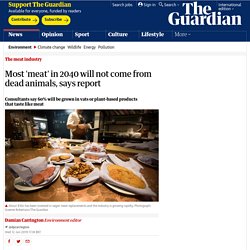
The report by the global consultancy AT Kearney, based on expert interviews, highlights the heavy environmental impacts of conventional meat production and the concerns people have about the welfare of animals under industrial farming. “The large-scale livestock industry is viewed by many as an unnecessary evil,” the report says. Make your own meat with open-source cells – no animals necessary. Emmanuel Pierrot/Agence Vu/Camera Press By Sandrine Ceurstemont IMAGINE producing meat at home without killing animals.
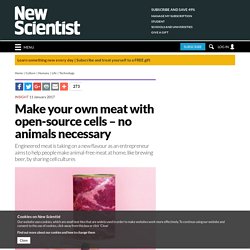
With a few cells and a keg, the process could be no more complicated than brewing your own beer or pickling vegetables. That’s the vision of Isha Datar, the CEO of New Harvest, a non-profit organisation aiming to create everything from burgers to silk from cell cultures. “It’s like designing a new universe,” she told Hello Tomorrow, an event that brought together technology entrepreneurs in Paris last year.
China Signed a $300 Million Lab-Grown Meat Deal with Israel. In Brief Israel is proving to be a hotspot for research into lab-grown meat.
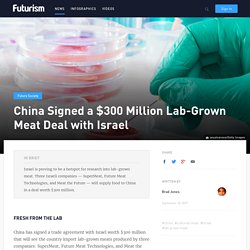
Three Israeli companies — SuperMeat, Future Meat Technologies, and Meat the Future — will supply food to China in a deal worth $300 million. Fresh From the Lab China has signed a trade agreement with Israel worth $300 million that will see the country import lab-grown meats produced by three companies: SuperMeat, Future Meat Technologies, and Meat the Future. This move is part of China’s ongoing effort to address its most pressing environmental problems.
The Israel Innovation Authority and the Israel Export Institute were involved in brokering the deal with China. 10 Signs the Food Industry Thinks the Future of Food is Plant-Based. How have consumer behaviors in recent years transformed the food industry?
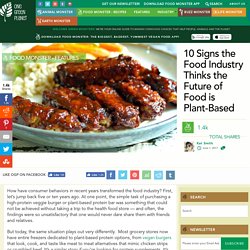
First, let’s jump back five or ten years ago. At one point, the simple task of purchasing a high-protein veggie burger or plant-based protein bar was something that could not be achieved without taking a trip to the health food store — and often, the findings were so unsatisfactory that one would never dare share them with friends and relatives. But today, the same situation plays out very differently.
Most grocery stores now have entire freezers dedicated to plant-based protein options, from vegan burgers that look, cook, and taste like meat to meat alternatives that mimic chicken strips or crumbled beef. Real Artificial: Tissue-cultured Meat, Genetically Modified Farm Animals, and Fictions. If they come, we will build it, in vitro meat and the discursive struggle over future agrofood expectations. Invitro meat economics study v5 march 08.pdf. Emerging Profiles for Cultured Meat; Ethics through and as Design.
Edelman.pdf. Test-Tube Burger: Lab-Cultured Meat Passes Taste Test (Sort of) Sci-fi fans and animal-rights activists alike have been announcing its arrival for decades, but in a world where food scientists are still trying to figure out the best ways to extend the life of cake, it’s hard to imagine that meat created in a petri dish might gain a place on our dinner plates anytime soon.
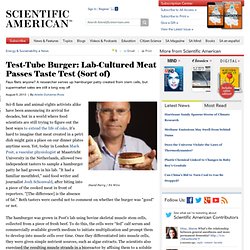
Yet, today in London Mark Post, a vascular physiologist at Maastricht University in the Netherlands, allowed two independent tasters to sample a hamburger patty he had grown in his lab. "It had a familiar mouthfeel," said food writer and journalist Josh Schonwald, after biting into a piece of the cooked meat in front of reporters.
"[The difference] is the absence of fat. " Both tasters were careful not to comment on whether the burger was "good" or not. The hamburger was grown in Post's lab using bovine skeletal muscle stem cells, collected from a piece of fresh beef. Post is hopeful that he will one day get the cost down to a more competitive price point. The In Vitro Meat Consortium - Home. Future Food - In Vitro Meat. In-Vitro meat is the (idea of) manufacturing of meat products through "tissue-engineering" technology.
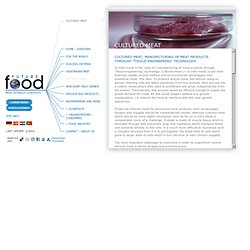
Cultured meat (= in-vitro meat) could have financial, health, animal welfare and environmental advantages over traditional meat. The idea: To produce animal meat, but without using an animal. Starting cells are taken painlessly from live animals, they are put into a culture media where they start to proliferate and grow, independently from the animal. Theoretically, this process would be efficient enough to supply the global demand for meat.
All this would happen without any genetic manipulation, i.e. without the need to interfere with the cells’ genetic sequences. Culturing Food, Bioart and In Vitro Meat. Cultured meat from stem cells, Challenges and prospects. Synthetic Steak, The Benefits of Multiplying Meat. Growing Meat in a Petri Dish, to Keep Your Plate Full. In Vitro Meat Production, Challenges and Benefits Over Conventional Meat Production. Maso 'ze zkumavky'. Izraelská firma chce vyrábět umělé kuřecí z několika buněk. Izraelská firma chce vyrábět umělé kuřecí z několika buněk (ilustrační foto)Foto: Jo Naylor, CC BY 2.0 Izraelská firma Supermeat oznámila, že do dvou měsíců začne s testováním takzvaného kultivovaného masa.

Plánuje ho vypěstovat v laboratorních podmínkách z několika buněk. Maso má přitom chutnat stejně jako to přírodní. Uměle vytvořenou stravu chce firma do pěti let začít prodávat na izraelském trhu. „Odebereme vzorek buňky zvířecího masa, v případě Supermeat půjde o buňku kuřecího. „Buňky budou mít pocit, že jsou stále uvnitř zvířecího těla. Uměle vytvořené maso má pomoci v boji s následky stoupající celosvětové živočišné produkce, která poškozuje životní prostředí. Maso „in vitro“ má být dokonce levnější než skutečné kuřecí a údajně i zdravější než to přírodní, protože bude od začátku do konce pod dohledem vědců. Zlepšit zdraví obyvatel a životní prostředí se snaží nejen soukromé firmy, ale také některé státy. Scientists Just Made Food From Electricity.
In Brief A Finnish research team has taken a step towards the future of food by developing a method for producing food from electricity.
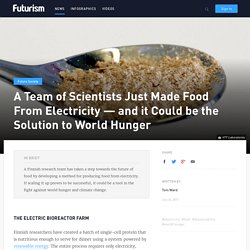
If scaling it up proves to be successful, it could be a tool in the fight against world hunger and climate change. The Electric Bioreactor Farm Finnish researchers have created a batch of single-cell protein that is nutritious enough to serve for dinner using a system powered by renewable energy. The entire process requires only electricity, water, carbon dioxide, and microbes. After exposing the raw materials to electrolysis in a bioreactor, the process forms a powder that consists of more than 50 percent protein and 25 percent carbohydrates — the texture can also be changed by altering the microbes used in the production.